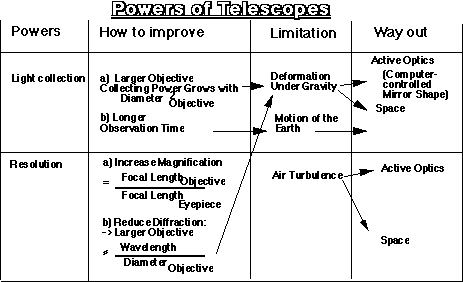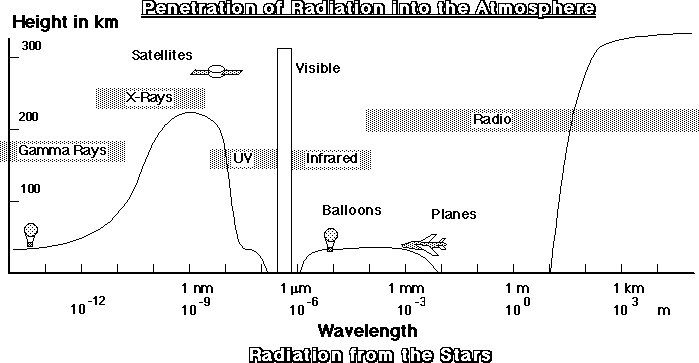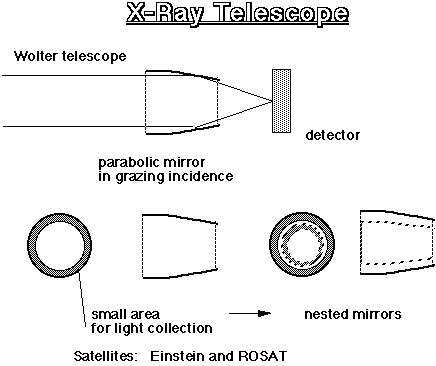V. Tools
in Astronomy and Astrophysics
So far used light and our eyes to gain information
about the sky:
Limitations:
- Sensitivity
- Resolution of our eyes
- Range of "Colors"
- Problems with optical trickery
To improve we need:
- knowledge about light
- provide better tools
1. Light etc.
A) Changes of the light path
a) Reflection:
- light rays bounce off a plane like an elastic
ball (mirror reflection)
incoming angle = exit angle
b) Refraction
- light is bent at the interface of two different
materials
- entering "denser" material (glass)
-> towards surface normal
- exiting "denser" material (glass)
-> away from surface normal
- explained by light as a wave (wavefront changes
direction with speed change)
B) Light is a wave
- Definitions:
- Wavelength:distance between 2 wavecrests
- Frequency:number of wavecrests passing
by in 1 second
- -> Wave Speed = Wavelength * Frequency
- Speed of light is finite, but incredibly fast:
c = 300,000 km/sec
- measured by Ole Roemer from orbits of Jupiter's
moons
- (information on moon's position
comes later when Jupiter is on the far side of the sun)
2. Optical telescopes
A) Lenses and curved mirrors
- Collect and concentrate light
- Produce images of distant objects at one focal
length away
B) Design of Telescopes:
- objective -> to gather light and produce
an image of the object
- eyepiece -> to serve as magnifying glass
to look at the image
- Use of lenses for objective and eyepiece->Refractor
- Use of a mirror for the objective, lense as
eyepiece->Reflector
C) Powers
and Limitations of Telescopes:

a) Light gathering:
- the larger the objective the better: scales
with area (diameter(objective)2)
b) Magnification of image (apparent (angular)
size DQ of object):
DQeye/DQobj
= fobjective/feyepiece (f = focal length of the
lenses)
c) Resolution of neighboring objects
the larger the objective the better: (objective
>>>> wavelength!)
The Limitation is diffraction
-
Narrow slit does not produce
a sharp slit image:
- a new wave starts at an obstacle when hit
by a lightwave and is bent around
- (like the circular waves starting from a stick
in the water, when hit by a wave)
D) Problems
and Limitations:
a) Lens errors
- chromatic aberration (due to dispersion)
- use mirrors (reflector telescope)
- other aberrations -> use correcting lenses
b) Support of weight of the objective
- distortion of mirrors or lenses by gravity
- ways out:
- make individual pieces(controlled by a
computer)
- go into space (weightless)
c) Motion of the air above observatory
- blurred image
- ways out:
- go on high mountains
- go into space
- use computer-controlled optics
3. Light is Electromagnetic Waves and/or Particles
A) Spectrum
of Light
a) Dispersion
- refraction for blue light stronger than for
red light
- Consequences:White light consists of all
colors
- Frequency or wavelength =
"color"
- Definition: Spectrum of light: the
amount of energy at each wavelength
b) Selective Reflection (produces colors)
- Colored object reflects only its own colors:
- selective reflection on solid surfaces
-> info on material on planets/moons
- red surface of Mars -> rusty iron
- yellowish parts of Io -> sulfur
c) Temperature (produces colors)
- Hot objects emit light:
- color (wavelength) of maximum intensity
depends on temperature
- color of star -> info on temperature
of star
- hotter -> blue -> shorter wavelength
and
- hotter -> shines brighter
- There is "light" even beyond red
(infra red) and beyond blue and violet (ultra violet)
B) Light
is Electromagnetic Waves
- Radio and TV transmission waves are similar
-> electromagnetic waves
- (all the same "stuff", only at different
wavelength)
| radio |
microwave |
IR |
red |
blue |
UV |
X |
gamma. |
| low frequency |
high frequency |
| long wavelength |
short wavelength |
| low energy photons |
high energy photons |
For all waves:
|
speed = c (the speed of light)
(All electromagnetic radiation
moves at c)
|
C) Light
is Particles
- Some measurements tell us light is particles
(particle nature = "photons").
- (electrons are knocked off by light, as if
hit by a particle)
- light is particles
- light acts like both: waves and particles
- Frequency or wavelength equivalent to photon
energy; both equivalent to "color"
4. Radiotelescopes
A) Uses
in astronomy
- all stars also emit radio waves (the sun is
very noisy)
- gas (cold stuff) radiates in radio regime
- remainders of supernovae emit radio waves
- developed as spin-off of radar technology
B)
Radiotelescope consists of
- antenna dish (collector for radio waves) and
- receiver (radio)(like satellite TV communication)
C)
Powers
- Signal collection: the larger the dish the
better
- Resolution: dish larger than optical telescopes,
but wavelength much longer!
- resolution worse than optical telescopes
- But telescope can be put together in pieces:
- With radio telescopes all over the Earth -> fake telescope as large
as the Earth
- resolution better than optical telescopes
If you want to know more, get the Radioastronomy
Tutorial from the Haystack Radio Observatory
5. Space Astronomy
A) The
atmosphere blocks radiation
- only visible light and radio waves reach the
Earth's surface
- (absorption by atmosphere, otherwise get fried
by UV and X-rays)
- observe rest of spectrum from space
B) IR
light:
- telescopes similar optical telescopes
- uses -> observe cool stars, star formation
C) UV
light:
- telescopes similar optical telescopes
- uses -> observe hot stars, local interstellar
gas
D) X-rays
a) Image with X-rays?
- wavelength m6; atom size-> mirror not smooth
any more
- but rough surface looks shiny under flat angle
-> Wolter telescope
- X-rays are reflected under flat angle (grazing
incidence)
- like skipping of a flat stone on a water surface
under a flat angle
You can also go to the class
movie on X-ray reflection.
X-ray telescopes are world champions in mechanical
accuracy (Guiness Book)

b) Which eyes for X-Rays?
c) Uses in astronomy-> observe violent processes,
star death
- normal stars (like sun) when active
- supernova remnants
- galaxies and clusters of galaxies (very hot
gas)

E)
Gamma-rays
a) Image from gamma rays
- use collision geometry of photons with electrons
to get arrival direction
- (as if playing billiard with electrons and
photons)
(Compton Telescope, built at UNH and MPE)
b) uses-> hottest and most energetic sites
in the universe
- black holes
- active galaxies
F) Particles
from celestial objects
a) Parameters to determine:
- Mass (M) -> composition, i.e, source of
particles (oxygen from Earth, Helium
from Sun)
- Energy (E) -> acceleration, heating
- best particle accelerators are in space
- Charge (Q)-> temperature at origin
- hot: -> atoms loose many electrons
Combine several methods to achieve this:
- Deflection in electric field-> stronger
for higher Charge (Q)
- Measure time-of-flight-> heavier (higher
mass (M)) is slower
- Detector-> more energy (E) -> larger
signal
Bring instruments beyond Earth's atmosphere
- near Earth, near other planets, rest of the
solar system
b) Which particles do we find in space?
- cosmic rays (energetic particles) from the
sun and other places in the galaxy
- solar wind from the sun
- plasmas around planets (magnetospheres)
- dust particles and meteorites
Go to Chapter VI



